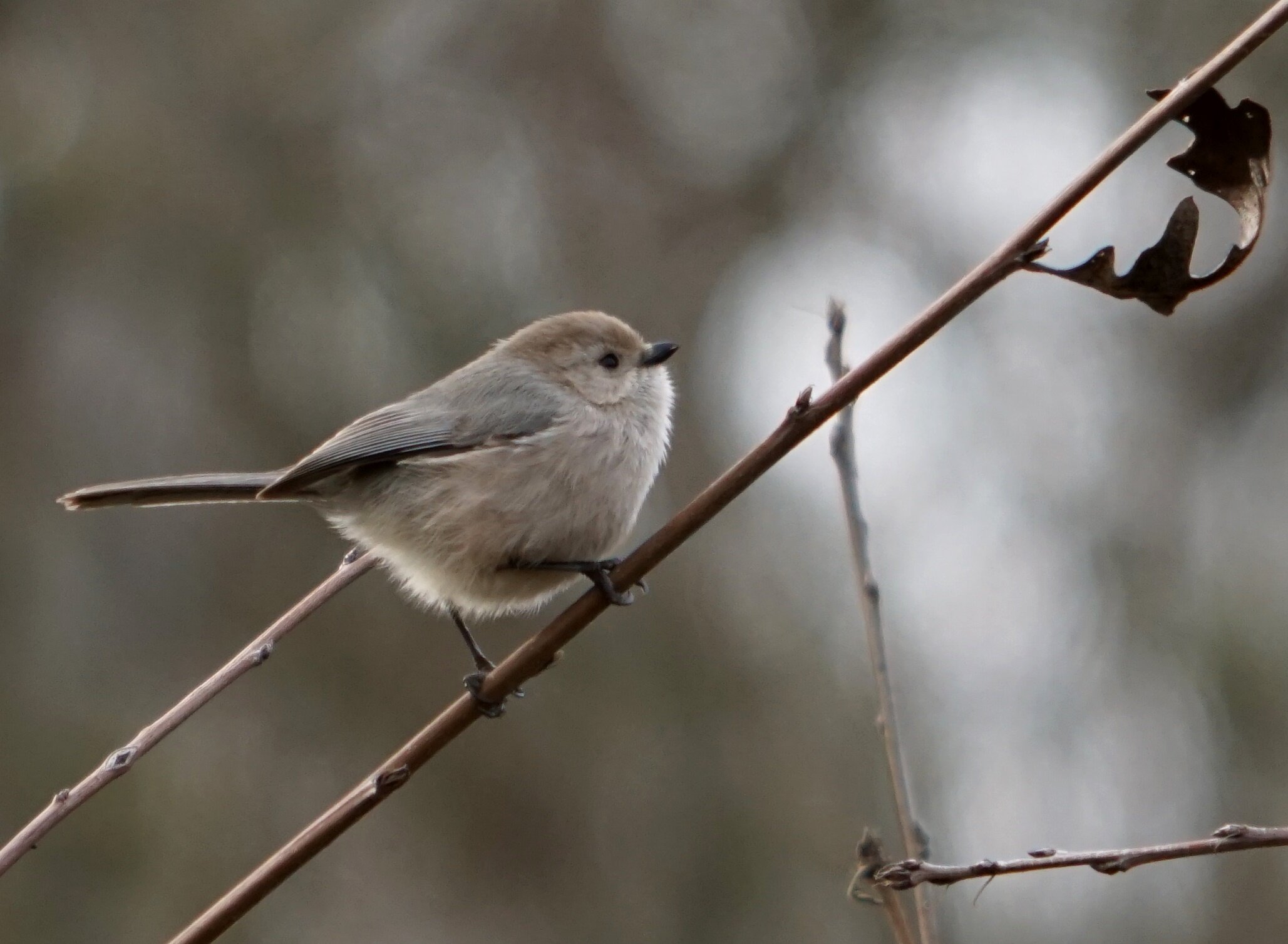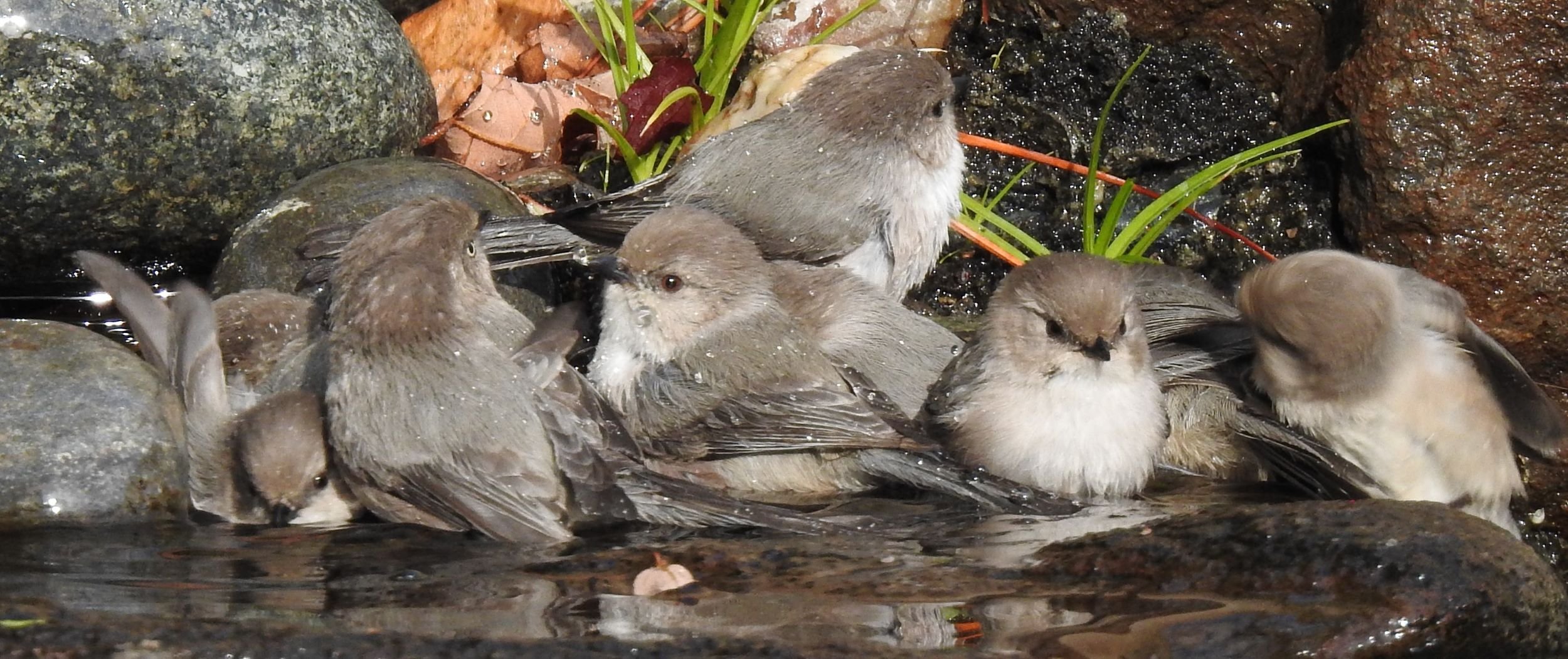Male Bushtit, Image by Chris Conard
This month, let’s talk about a very active songbird that's often seen in the Sacramento area called the Bushtit. The name Bushtit is derived from the Old Icelandic “titr” which means something small. Bushtits are one of the smallest bird species in North America. They are related to chickadees and titmice, and are similar in size to kinglets. Their range includes the southernmost part of western Canada, the western U.S., Mexico, and Guatemala. Bushtits don’t usually migrate (or change their location according to season). They usually stay in the same area year-round. However, Bushtit populations that stay in higher elevations in the summer months may move down to a lower elevation for the winter. Occasionally, they may travel a bit further to locate a warmer winter area.
Bushtits do not seem all that concerned when there are humans standing nearby. When searching for food, they seem to be preoccupied and in constant motion. Bushtits are social birds and form flocks of 10-40 birds or more after their nesting season is over. On cold nights, a Bushtit flock sometimes will huddle together to share body heat. Bushtits help keep their flock together by using sound. They continuously call out to each other as they travel. When a flock flies into an area, the group quickly begins to search for food. Soon they will take flight again, in single file, to investigate another tree or location. Bushtit flocks will repeat this foraging technique over-and-over throughout the day. Sometimes birds from other species, such as warblers, kinglets, or chickadees, join Bushtits in search of food and water. When birds form a large group, there is a greater success rate in finding ideal locations that offer ample food for all the participants. This is also a way to have safety in numbers.
What do Bushtits look like?
Female Bushtit, Image by Chris Conard
Bushtits are plain and tiny birds about 3 inches in length. They are brown and gray on top and have slightly lighter, grayish-white, breasts. Bushtits have round bodies, short pointed bills, short necks, long tails that seem to drag in flight, and relatively large heads. Males and female birds look similar except that males have dark eyes and females have light-colored (or golden) eyes.
There are geographical differences in coloration and markings in Bushtit populations. Here in the interior valley and foothills, Bushtits have gray heads and brown ear patches. Those living near the coast have brown heads. Some male Bushtits found in the south (in Texas, Arizona, and Mexico, for example) have a blackish cheek area that resembles a mask.
Where do Bushtits live?
Bushtits live in a variety of habitats. They are found in open woodlands, forests, scrub or sagebrush habitats, riparian areas (areas situated near banks of a river), suburban parks, and residential gardens. Bushtits are not commonly found in high mountainous areas or in the hot desert regions of the West.
Bushtit near nest, Image by Larry Hickey
Bushtits will produce 1-2 clutches (groups of eggs) per year. Both parents help to weave very unique, hanging nests, up to a foot in length, that are constructed out of spider webs, twigs, rootlets, grass, moss, and leaves. Bushtit nests may take up to a month or more to build and are at various heights; but the nests are often low enough to visualize. Spider web is used to hold the grassy structure together. An entrance hole is located on the side of the nest, near the top. The nest is lined with soft and insulating material such as fur, cushiony plant material, and feathers. Bushtits will often attempt to camouflage their nests by placing leaves or other plant materials around the outside. Both parents usually sleep inside the nest with their eggs or young birds at night. In addition, both parents will incubate the eggs (keep the eggs warm using close contact), care for, and feed their young. Bushtits aren’t territorial towards other Bushtits or even with other bird species. Sometimes, a few additional adult Bushtits (usually males) help the parents care for the nestlings and are welcome to sleep inside the nest too! Young birds (fledglings) will leave the nest about 14-18 days after hatching.
Bushtits, Image by Mary Forrestal
What do Bushtits eat?
Bushtits are omnivores meaning they will eat both animal and plant based foods. They mainly eat spiders and insects, such as aphids, scale, leafhoppers, caterpillars, larvae, beetles, wasps, and ants. However, in cooler weather when live food is difficult to find, Bushtits will eat berries, fruits, and seeds. They will occasionally come to seed feeders or to seed that has been scattered on the ground. Because Bushtits are small and nimble birds that can easily hang upside-down on twigs, they find it easy to search for insects or spiders that are hiding on the underside of leaves or pine needles. Larger bird species usually search on the tops of foliage when they forage (search) for live food. In the cold winter months, Bushtits’ rate of body heat loss is high and they must consume about 80% of their body weight per day in order to not lose weight!
What do Bushtits sound like?
Bushtits have several calls. Some sources feel that Bushtits have songs and other think they only have calls. They frequently use various short and simple contact sounds (or calls) to communicate. Bushtits use different calls for different occasions such as: “It’s time to move to another spot; you should follow me”. They also may use a certain call for perhaps: “ Beware! There's a large raptor overhead”. The calls made by Bushtits have been described as high-pitched buzzing chips, loud chattering notes, soft chips and twitters, and as being scratchy or wispy. Listen to the Bushtits now below:
These songs and calls of the Bushtit are from xeno-canto. More Bushtit vocalizations can be found at xeno-canto.org/species/Psaltriparus-minimus.




